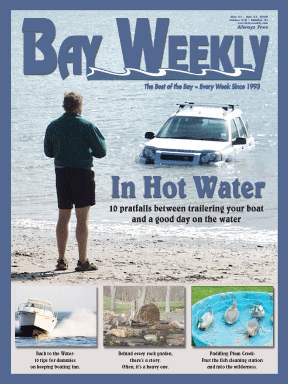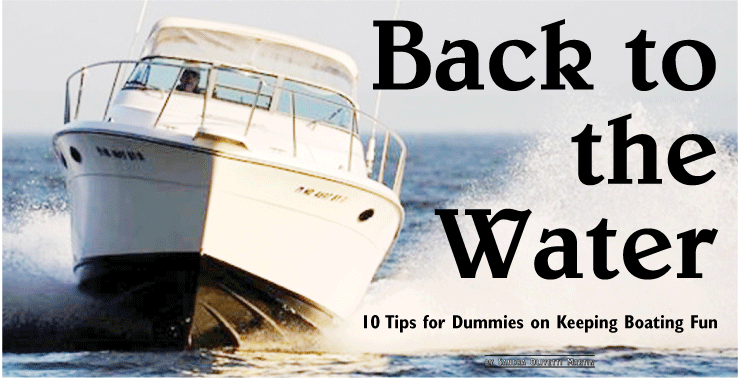
Volume XVII, Issue 21 # May 21 - May 27, 2009 |
 |

 Boating is Maryland’s most popular sport. After what always seems to be an extraordinarily long winter, finally we’re at the time of year the sporting season begins in earnest.
Boating is Maryland’s most popular sport. After what always seems to be an extraordinarily long winter, finally we’re at the time of year the sporting season begins in earnest.
The day is beautiful, and you’re just going down the Severn or across the Bay. What could happen?
Disaster.
Safe Boating CalendarMaryland Department of Natural Resources offers dozens of safe boating classes all over Chesapeake Country this summer. Find them listed by county and date: http://dnrweb.dnr.state.md.us/nrp/boatingclass.html Coast Guard classes: http://a054.uscgaux.info/News%20and%20Information/Public%20Education/maryland.htm Annapolis Sail & Power Squadron classes for begining and serious boaters: http://www.aspsmd.org/education.htm United States Power Squadron classes: http://www.usps.org/cgi-bin-nat/eddept/cfind.cgi
Saturday, May 30Safe Boating DayKick off the boating season with life-saving fun at the Coast Guard, Coast Guard Auxilliary and Department of Natural Resources’ Safe Boating Day. Kids ride on a Coast Guard patrol boat, meet Coastie the boating safety robot and play with Peter Panda and Sammy the Sea Otter. Boaters have their vessels inspected for safety, study a rescue-swimmer demonstration and review the rules of the water in 30-minute refresher classes. 10:30am-3pm @ Sandy Point State Park, off Rt. 50, before the Bay Bridge: 410-760-5025. Saturday, June 13Sail & Power Squadron Yard SaleShop at the Annapolis Sail & Power Squadron’s Yard Sale to fund free safe boating classes. 9am-2pm @ 1131 Old County Road (off Jones Station Rd. W), Severna Park: [email protected]. |
A simple mistake, oversight or mid-summer squall can turn into an emergency. All sorts of things can go wrong when boats bring people and water together, from wild weather to rogue wakes to collisions in the dark of night. Add inexperience, inattentiveness and alcohol, and fun can go wrong in an instant.
In April, before boating season’s serious start, boating excursions gone wrong took the lives of three boaters. Two were lost after their boat capsized. One apparently fell overboard.
Here, for National Safe Boating Week 2009, Bay Weekly has collected the advice of expert captains — including our own Allen Delaney and Grant Zeigenfuse — to bring pleasure boaters 10 top tips on keeping your boating fun this season.
Before You Go on the Water
1. Have the skills to get back home
If you’re not one of the lucky ones who, growing up on the water, learned boating and walking at about the same time, you’d better take to the classroom before you take to the water. If you were born after July 1, 1972, Maryland law says you have to. If you were born before that date, you’re old; DNR figures that by now you should know better.
You get about twice that much classroom time in the Safe Boating and Seamanship classes offered by both the U.S. Coast Guard Auxiliary and the U.S. Power Squadron. A lot is packed into those sessions, from safety to marlinespike seamanship — that’s knot-tying to landlubbers — to anchoring to using a compass to reading charts and plotting a course.
Good as the survey classes are, they’re only introductions. Both Coast Guard Auxiliary and U.S. Power Squadron also teach advanced classes, including navigation. You can also charter a teaching captain to help you bridge the gap from head to hand aboard, on your boat or theirs.
2. Update your life-saving wardrobe
Like April’s deaths, most boating accidents happen when someone falls overboard or a boat capsizes. personal flotation devices are lifesavers, but once you hit the water, they’ll save your life only if you’re attached.
Will statistics make you a believer?
Eighty percent of fatalities on the water could have been prevented, says Maryland Natural Resources Police spokesman Art Windemuth, by wearing life jackets.
How about when the statistics hit close to home? None of the three boaters who died in Maryland waters in April was wearing a life jacket.
It only works if you wear it, DNR preaches, but there’s no law requiring most adult pleasure boaters to wear their personal flotation devices. Water skiers and operators and riders of personal watercraft are the exception: they must wear PFDs. So must children on all sorts of boats.
3. Make your boat seaworthy
Service your boat or have it done professionally before you get back on the water. What you want — unless you don’t mind trouble on the water — is for your boat to be in top shape from stem to stern. That means inspecting and maintaining the engine, belts, hoses, fluids, through-hull fittings and outdrive gaskets, for a start. Worn rubber, ruptured hoses or a loose clamp on a holding hose can sink a boat.
If any of this is Greek to you or if you think the list stops there, get a professional to do your inspection and service. Don’t skimp on price; be sure your mechanic is reliable; review the work that’s been done.
Consider the cautionary tale of the Chesapeake Country pleasure boater who was sea-testing the boat he’d just had serviced. He was returning to port confidently, when a fuel line fouled and the engine failed. In an instant — too short and too busy a time for passengers to put on their PFDs — the powerless boat drifted onto the rocks. Even if you’re confident your boat is in top shape, be prepared for trouble. Stock your repair kit with spare hoses, clasps, fuel and oil filters, oil and belts.
Over the Memorial Day weekend, 3,400 recreational boaters and anglers nationwide will need on-the-water assistance, according to BoatU.S. Towing Services. The biggest reason? Incomplete spring commissioning.
4. Call the Coast Guard for a Safety Check
A Coast Guard Safety Check won’t guarantee your safety, but it will help you take care of yourself. Inspectors, who are volunteers with the Coast Guard Auxiliary, board your boat to walk you through a 27-item checklist to make sure you have proper, serviceable safety equipment aboard.
They’ll take the time to let you know what’s what — and what isn’t: Are your navigation lights working? How about your horn? Are your flares out of date? Are you carrying a daytime safety signal, an orange flag? Has your fire extinguisher expired? Is it attached to the boat where you can reach it if you need it — but not trip on it when you don’t? Is your anchor suitable and secure?
Before Each Trip
5. Consider the weather
On Chesapeake Bay, ignoring the weather is one of the surest ways to get in trouble.
“It can change fast,” advises Captain Mickey Courtney, who combines 30 years in the Coast Guard Reserve with 15 years in Natural Resources Police. “On any shallow body of water, when winds are strong enough, it can rapidly blow up.”
In the Bay, waves won’t get as high as in the open ocean. Six feet here is pretty significant, and up to seven feet is exceptional. But Chesapeake Bay’s shorter waves hit harder, as Courtney explains: “When you have six-foot seas in the ocean, the period of the waves is farther apart and the waves stretched out, easier to negotiate. In the Bay’s shorter period, you get steep, breaking, bone-jarring slamming about.”
Check two weather sources before setting out: The Weather Channel for a broader report and NOAA weather radio on VHF, which reports a constant reading from data buoys throughout the Bay area.
The winds were strong and waters rough on April 4, when a small, open fishing boat capsized on the Nanticoke River. Cody Coulbourne’s body was recovered April 16. The other boater remains lost.
6. Fuel with care
Powerboaters who want to return home under their own power swear by the one-third rule. That’s one-third tank to take you to your destination, one-third to bring you back home, one-third in reserve.
Fueling is one of the danger spots for boaters. To drive this point home, each Coast Guard boating safety class begins with a dramatic visual of an explosion at the fuel dock. Don’t provide them a new picture.
“Can you say BOOM?” Capt. Delaney wants to know. He says sticks to outboards because inboard engines have a nasty habit of collecting gasoline fumes in the engine compartment.
For this reason they must be vented for at least five minutes prior to starting the engine. If not, or if the exhaust fan is not functioning, the spark from the plug can ignite the vapors and make for a rather unpleasant day, especially when your burning boat begins floating toward other vessels moored in their slips.
7. Check your electric
Remove batteries caps and peer in to see that water is covering all the plates. Fill with distilled water. Make sure cables are clean and tight.
Another kind of power can give you trouble, too. If you’re using a shore tie, make sure you unplug it before taking off.
8. Load for shore leave
Develop your own boating checklist and review it each time you go out, modifying what you bring with the kind of trip you’re taking. Don’t leave shore without safety and first aid supplies, including insurance. Since towing costs mount high and quickly, consider a Boat/U.S. membership, the boater’s equivalent of American Automobile Association.
Next, don’t overload. Read and believe the capacity plate posted in your boat. Distribute human and load weight evenly so your boat is properly trimmed. Stow whatever you can in lockers, not on deck where objects can fly free or trip you when you’re underway. A boat is not a house, as you’ll remember as soon as it gets rough.
9. Know where you are
If you’re a first-time boater or setting off from an unfamiliar location or new launching ramp, get the lay of the land before you set out on the water.
Locate your position on your chart, paper or electronic. What are the aids to navigation? Are there special conditions of geography, current or crowding? Is the channel narrow? Do sandbars lurk? Which way do you turn to reach open water?
On Board
10. Don’t get lost
Know how to read a chart, compass and GPS — and have all on board and working. Both Coast Guard or Power Squadron introductory courses give you a foundation in those skills.
New boats and technologically savvy boaters use electronic charts nowadays, but paper charts that give you the big picture are still worth the price. Popular bound charts are Maryland Cruising Guide, a saddle-stitched volume Courtney edits and revises every two years; and the spiral-bound annual ADC Chesapeake Bay Virginia and Maryland Chartbook.
You need to know where you are so you can find your way home or tell somebody where to come and get you.
If all this advice isn’t enough, Natural Resources Policeman Windemuth hopes you’ve told a friend or neighbor where you were going, how long you expected to be gone and when you’re due back. That, he says, is so if you don’t turn up when expected, “We can start searching.”
